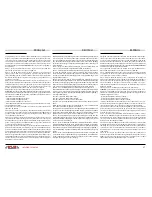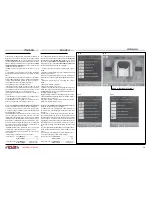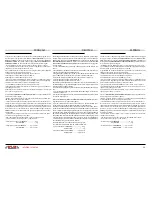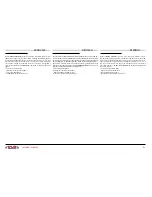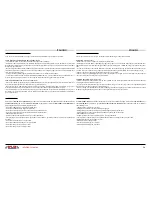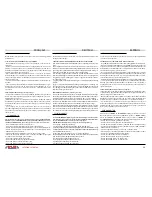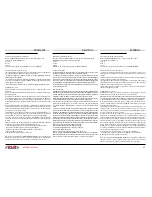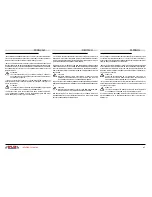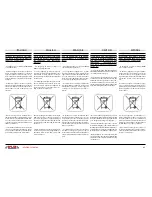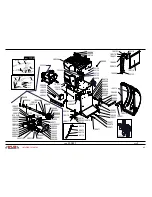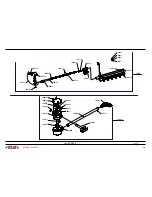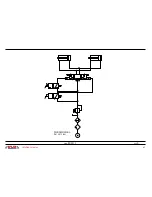
34
solutions creator
ITALIANO
ENGLISH
TARATURA BASE DELLA MACCHINA
Sono neccessari due metodi di prova per assicurarsi che l’equilibratura avvenga in modo perfetto.
PROVA DI BUON FUNZIONAMENTO DELLA BILANCIATURA
• Si equilibrano sulla macchina i due lati della ruota, seguendo le istruzioni.
• Quindi si produce artificialmente uno squilibrio, applicando un peso di 50 grammi su uno dei due lati. La macchina
deve indicare esattamente questo squilibrio, sia l’entità che la posizione, mentre può esservi un’indicazione massima
di 5 grammi per l’altro lato.
• Per controllare la posizione dello squilibrio si gira la ruota sulla posizione di squilibrio indicata dalla macchina tramite
l’indicazione delle frecce sul monitor (ore 6). In tale posizione, il peso di prova applicato deve trovarsi verticalmente
sotto l’asse di rotazione (ore 6).
• Se vi sono delle deviazioni angolari chiaramente visibili, occorre rettificare l’indicazione.
• Se si verificano deviazioni inaccettabili sull’entità di squilibrio indicato, per il lato della ruota dove è applicato il peso
di prova, oppure c’è un’indicazione eccessiva sull’altro lato della ruota, bisogna ritarare la macchina.
PRECISIONE DI CENTRATURA (Qualità di Equilibratura)
• A tal scopo si può impiegare la ruota già equilibrata nella prova precedente. Togliere il peso di prova. Quindi sbloccare
la ruota dall’attrezzo adattatore e ribloccarla, ma spostata di circa 35°.
• In un lancio di prova, l’indicazione non deve superare un massimo squilibrio di 5 grammi su ogni lato (10 g. in caso
di ruote particolarmente pesanti). Questo errore è dovuto alle tolleranze nella centratura del cerchio.
• Una centratura precisa è essenziale sia per questa prova che nella normale procedura di equilibratura. Se in questo
lancio di prova si rileva uno squilibrio elevato, bisogna controllare l’usura, i giochi e la sporcizia delle parti impiegate
per centrare la ruota.
AUTODIAGNOSI
È prevista una PAGINA di AUTODIAGNOSI per verificare il corretto funzionamento della macchina equilibratrice: dalla
PAGINA PRINCIPALE premere il tasto MENÙ di SERVIZIO; da qui, premere il tasto AUTODIAGNOSI EQUILIBRATRICE; in
questa pagina il monitor visualizza i seguenti valori:
• tensione di alimentazione e tensione di riferimento;
• tensioni dei calibri distanza, larghezza, diametro;
• tensione e fase del pick-up interno (rilevato durante l’ultima misura);
• tensione e fase del pick-up esterno (rilevato durante l’ultima misura);
• differenza di fase (calcolato);
• posizione angolare (in impulsi encoder: da 0 a 399) dell’albero;
• velocità (in giri al minuto) dell’albero: premendo il tasto START è possibile verificare la velocità di regime della
macchina.
• tensione di uscita dal sensore di rotondità.
• tensione di alimentazione del sensore di rotondità.
• tensione pick-up interno (in tempo reale).
• tensione pick-up esterno (in tempo reale).
BASIC MACHINE CALIBRATION
Two test procedures are necessary to ensure that wheel balancing is conducted accurately.
BALANCING ACCURACY TEST
• Balance the two sides of a wheel according to the instructions.
• Artificially create an imbalance by fitting a weight of 50 grams on one side of the wheel. The machine should iden-
tify this imbalance precisely, both for weight and position. A reading up to a maximum of 5g is possible for the other
side.
• In order to check the position of the imbalance, turn the wheel to the balancing position as indicated by the arrows
on the monitor (6 o’clock). In this position the test weight should be vertically below the rotation axle (6 o’clock).
• If there is an obvious angular error the indicators have to be rectified.
• If there is an unacceptably big weight error on the side with the test weight, or an excessive figure for the opposite
side of the wheel, the machine has to be recalibrated.
CENTRING PRECISION (Balancing Quality)
• The wheel balanced in the previous test can be used. Remove the test weight. Release the wheel from the adapter
and retighten it, but rotated by about 35°.
• In a test cycle the imbalance must not exceed a maximum of 5 g on each side (10 g in the case of particularly heavy
wheels). This error is due to the rim centring tolerance.
• Precise centring is essential both for this test and during normal balancing operations. If this test run produces a high
imbalance reading check the parts used for centring the wheel for wear, play, and dirt.
SELF-DIAGNOSIS
A SELF-DIAGNOSIS PAGE is provided to check the correct operation of the balancing machine. From the MAIN PAGE press
the SERVICE MENU key. From here, press the WHEEL BALANCER SELF-DIAGNOSIS key; in this page the monitor displays
the following vaues:
• Supply voltage and reference voltage.
• Voltages for the distance, width, and diameter gauges.
• Voltage and phase of the internal pick up (read during the last measurement).
• Voltage and phase of the external pick up (read during the last measurement).
• Phase difference (calculated).
• Angular position (in encoder impulses: from 0 to 399) of the shaft.
• Speed (in rpm) of the shaft: by pressing START the machine’s operating speed can be checked.
• Output voltage from the roundness sensor.
• Roundness sensor supply voltage.
• Internal pick-up voltage (in real time).
• External pick-up voltage (in real time).
Содержание WB 690
Страница 2: ......
Страница 47: ...47 solutions creator cod 400111 rev 0 PRESSIONE ESERCIZIO DA 1 5 A 12 bar ...








